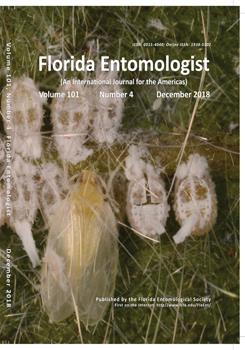Mandarin (Citrus reticulata) is an economically important fruit for farmers of the inter-Andean valleys of Ecuador, South America. Insectinfested fruits were sampled in the locality of Perucho (Pichincha Province). The larvae obtained from the interior of the fruit were cultured in insect cages to obtain adults. Morphological observations of characteristics of the larval stage, and male and female genitalia at the adult stage confirmed the taxonomic description of the species Gynmandrosoma aurantianum (Lima) (Lepidoptera: Tortricidae). According to our knowledge, this is the first report of mandarin being infested by G. aurantianum in Ecuador.
Tortricidae is one of the most extensive and diverse families of the order Lepidoptera, with approximately 10,000 species described throughout the world. The highest diversity of this family is in the tropics of America (Baixeras et al. 2010). Currently, this family comprises about 1,050 genera (Horak 2006) distributed among 3 subfamilies: Tortricinae, Olethreutinae, and Chlidanotinae (Horak 1998). Tortricids include numerous pests of fruit, forest, and ornamental crops (Zhang 1994), and among the most important of these pests are Cydia pomonella L., Lobesia botrana Denis & Schiffermüller, and Gynmandrosoma aurantianum (all Lepidoptera: Tortricidae). The latter species went through several taxonomic revisions. In 1915, it was identified and reported for the first time by Gregorio Bondar as Tortrix citriana Fernald (Carvalho 2003). In 1927, it was redescribed and relocated taxonomically as Gynmandrosoma aurantianum (Lima), and in 1995 it was transferred to the genus Ecdytolopha as Ecdytolopha aurantiana (Powell et al. 1995). Finally, Adamski & Brown (2001) made a taxonomic revision of the genera Ecdytolopha (Zeller), Gymnandrosoma (Dyar), and Pseudogalleria (Ragonot) in America and concluded that the species aurantianum (Lima 1927) belonged to the genus Gymnandrosoma and not to the genus Ecdytolopha.
Gymnandrosoma aurantianum (Lima) is widely distributed in South American countries such as Argentina, Brazil (Minas Gerais, São Paulo, Santa Catarina), Colombia, Ecuador, Peru, and Venezuela; in Central America in Costa Rica and Nicaragua; and in some Caribbean islands such as Dominican Republic, Haiti, Puerto Rico, and Trinidad and Tobago. It infests various hosts such as Citrus (Rutaceae), Robinia (Hemiuridae), Macadamia (Proteaceae), Pithecellobium (Fabaceae), Theobroma (Malvaceae), Psidium (Myrtaceae) (Adamski & Brown 2001), and Plukenetia (Euphorbiaceae) (Leandro 2013).
This pest has been reported to infest orange (Citrus × sinensis) in Ecuador (Cabrera-Asencio et al. 2012), but there is no record of this species infesting mandarin (C. reticulata [Rutaceae]). Economic losses to the farmer of up to 40% may occur because the larva feeds on the mesocarp of the fruit (Fig. 1A). Morphological identification of different life stages of G. aurantianum will facilitate the development of integrated pest management strategies to reduce the pest population in the mandarin cultivars of the inter-Andean valleys of Ecuador.
Specimens were obtained from infested mandarin fruits in commercial mandarin plantations in the locality of Perucho (0.108343°W, 78.424176°N) in the province of Pichincha. Fruit samples containing larvae were taken to the laboratory (temperature: 17 °C, RH: 58%), where the insects completed their life cycle in insect cages. The larval, pupal, and adult stages were documented photographically. The immature stages were preserved in 70% alcohol, whereas adults were killed with ethyl acetate and then mounted with entomological pins. The genitalia of the imagos were extracted and prepared according to the protocol proposed by Hardwick (1950). The description of external characters and genitalia was carried out using the key of Adamski and Brown (2001).
Larva. The length of late instar larvae was between 16 and 19 mm (Fig. 1B) and the average weight was 0.082 ± 0.03 g (± SD) (n = 20). Individuals showed a large abdominal pinacula with defined brown spots. The head and prothoracic shield varied between pale yellow and pale orange, but were brown at the final instar.
Pupa. The pre-pupae produced silk cocoons and wrapped themselves for approximately 18 d. Their color varied from brown in the first days to dark brown thereafter. Pupal length (n = 15) was between 6 and 8 mm (Fig. 1C).
Adult. The observation of external morphological characters coincided with the description made by Adamski and Brown (2001) in which they pointed out that adults are brown with indistinct reddishbrown and black markings, and all individuals have a conspicuous white dot on the distal one-third of the forewing (Fig. 1D). Males (n = 5) had flattened antennae that were notched at the base (Fig. 2A) and a large hairpencil on the hind tibia (Fig. 2B). Females had no distinctive external morphological traits; thus, it was necessary to dissect the genitalia to identify them.
Male genitalia had a dense row of deciduous hairs in the cornuti, which is located on the apical section of the aedeagus (Fig. 2C). This internal morphological trait was specific to males of this species (Adamsky & Brown 2001). Female genitalia were characterized by the presence of the ductus seminalis on the side of the ductus bursae. The ductus seminalis was closer to the ostium bursae than the ductus bursae (Fig. 2D).
In conclusion, G. aurantianum was identified infesting mandarin fruits in the inter-Andean Valleys of Ecuador. According to our knowledge, this is the first report of G. aurantianum infesting C. reticulata in Ecuador.
Fig. 1.
(A) Gymnandrosoma aurantianum larvae infesting mandarin (Citrus reticulata) fruit; (B) Larva at fifth instar; (C) Pupae (ventral, lateral, and dorsal views); (D) Adult of Gymnandrosoma aurantianum.

The authors thank the National Institute of Agricultural Research (INIAP) for supporting this research, and the Association of Small Farmers of Perucho for helping with the sampling. Thanks to the Project “Biocontrol systems for sustainable agriculture, Ecuador” funded by MFAT–New Zealand for the support of this research. Thanks to H.R. Kutcher from the University of Saskatchewan for editing the manuscript. Agreement MAE-DNB-CM-2015-0024-M-001.






